ISSN ONLINE(2319-8753)PRINT(2347-6710)
ISSN ONLINE(2319-8753)PRINT(2347-6710)
Dhanasri K1, Kishore Kumar M2
|
| Related article at Pubmed, Scholar Google |
Visit for more related articles at International Journal of Innovative Research in Science, Engineering and Technology
The demand of natural sand in the construction industry has consequently increased resulting in the reduction of sources and an increase in price. In such a situation crusher dust can be an economical alternative to the river sand. The Blast furnace slag is a waste of industrial materials, it is relatively more recent pozzolanic material that has received considerable attention in both research and application. It is a non-metallic product consisting essentially of Silicates and Alumino silicates of calcium's developed simultaneously with iron in a blast furnace and is granulated by quenching the molten material in water or steam, and air. The present Investigation has been undertaken to study the effect of blast furnace slag and crusher dust on the mechanical properties of concrete, when coarse aggregates is replaced by blast furnace slag and crusher dust is replaced with fine aggregate in different percentages i.e. 0%, 10%, 20%, 30%, 40%, 50%, 60%, 70%, 80%, 90% and 100%. The main parameters investigated were cube compressive strength, split tensile strength and flexural strength. The tests were conducted on concrete with ratio 1:1.86:3.77.
Keywords |
| Blast Furnace Slag, Crusher Dust, Compressive Strength, split Tensile Strength and Flexural Strength. |
INTRODUCTION |
| Sustainable construction mainly aims at reduction of negative environmental impact resulted by construction industry which is the largest consumer of natural resources. Over a period of time, waste management has become one of the most complex and challenging problem in the world which is affecting the environment. The rapid growth of industrialization gave birth to numerous kinds of waste by products which are environmentally hazard and creates problems of storage. Always, construction industry has been at forefront in consuming these waste products in large quantities. Blast furnace slag is a non-metallic material consisting of silicates and aluminosilicate of calcium and magnesium together with other compounds of sulphur, iron, manganese, and other trace elements. The successful utilization of crusher dust as fine aggregate and blast furnace slag as coarse aggregate would turn this waste materials that causes disposal problem into a valuable resource. The utilization will also reduce the strain on supply of natural fine aggregate, which will also reduce the cost of concrete. The main objective of the present investigation is to evaluate the possibilities of using crusher dust as a replacement to fine aggregate and blast furnace slag as a replacement to coarse aggregate. Present investigation aimed at to study, 10%, 20%, 30%, 40%, 50%, 60%, 70%, 80%, 90% and 100% of traditional fine aggregate was replaced with quarry dust and coarse aggregate was replaced with Blast furnace slag. Compressive strength, split tensile strength and flexural strengths were found after 7 days and 28 days of curing. |
EXPERIMENTAL PROGRAM AND TEST RESULTS |
| Ordinary Portland cement of grade 53 conforming to the Indian standard specification, sand of grading zone II obtained from Godavari river bed, Crusher Dust and Blast Furnace Slag has been used. Fine Aggregate, coarse aggregate, crusher dust and blast furnace slag were tested and found to conform to IS 383-1970 and their physical properties are given in Table 1. |
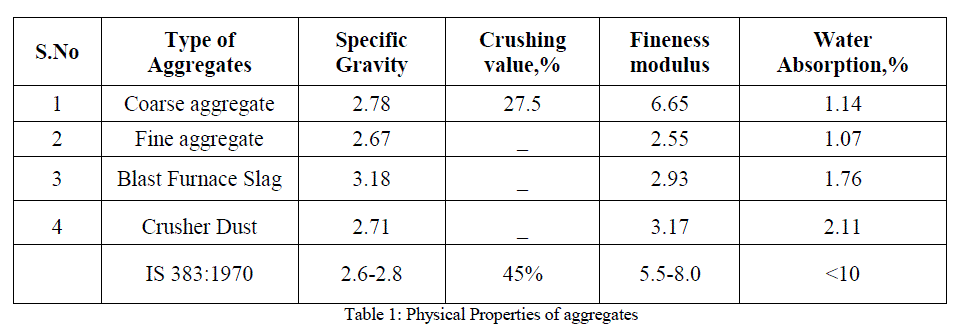 |
| Mix design and Mix proportions |
| The designed concrete mix (1:1.86:3.77), for a target mean strength of 26.6 MPa, contains ordinary Portland cement, sand conforming to grading zone II, Crusher Dust as fine aggregate and Blast Furnace Slag as coarse aggregate are used respectively. The w/c ratio was 0.45 in the present control mix designated. |
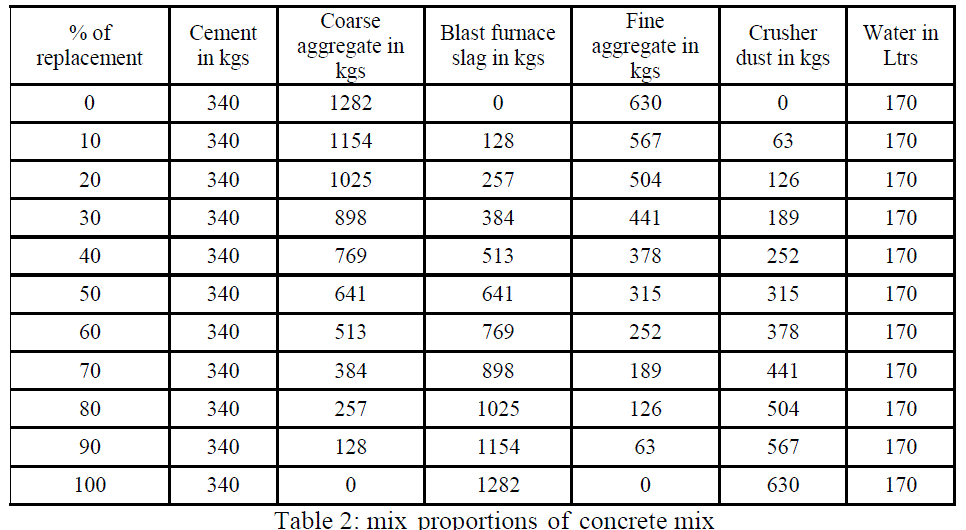 |
| Cube Compressive Strength of concrete mixes |
| The compressive strength of the concrete speciemens at 7 days and 28 days were illustrated in table 3. Fig. 1 depicts that the early age compressive strength of concrete specimens can be improved marginally by incorporating 30% crusher dust in place of river sand and beyond which the decreasing trend is observed. On the other hand, the strengths of concrete mixes at the age of 28 days is same as controlled concrete with increasing percentage replacement of river sand with crusher dust and coarse aggregate with blast furnace slag up to 30% and thereafter shows again the decreasing trend. |
| Split Tensile Strength |
| The split tensile strength of the concrete speciemns at 7 days and 28 days were tested and the results are ahown in table 3. The tensile strength of concrete mixes are increased marginally till 30% replacement of revier sand with cusher dust and coarse aggregate with blast furnace slag. Hence the crusher dust and blast furnace slag can be effectively introduced in place of river sand and coarse aggregate with blast furnace slag in concrete mix . |
| Flexural Strength |
| The flexural strength of concrete specimens at 7 days and 28 days are given in table 3. Only marginal increase in the fluxural strength of concrete specimens were observed with a replacement of up to 30% of river sand with crusher dust and coarse aggregate with blast furnace slag. |
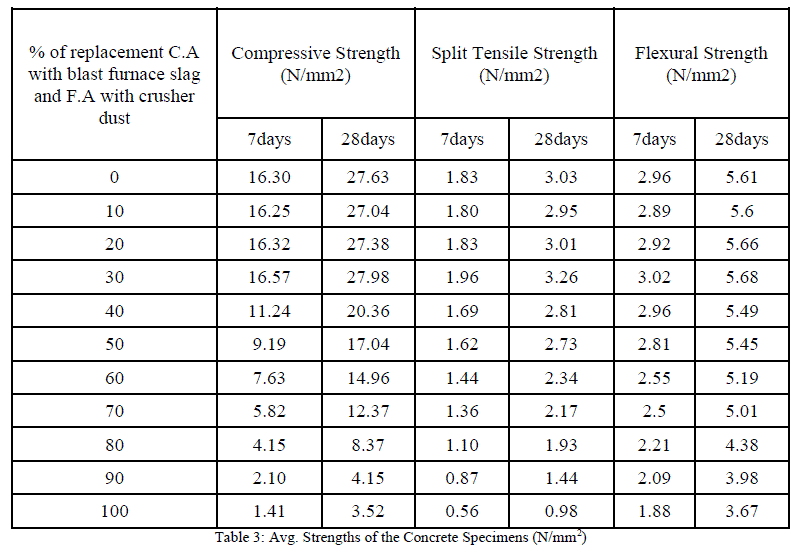 |
TEST RESULTS ON HARDENED CONCRETE |
| These tests were conducted for 28 days and the results are as below: |
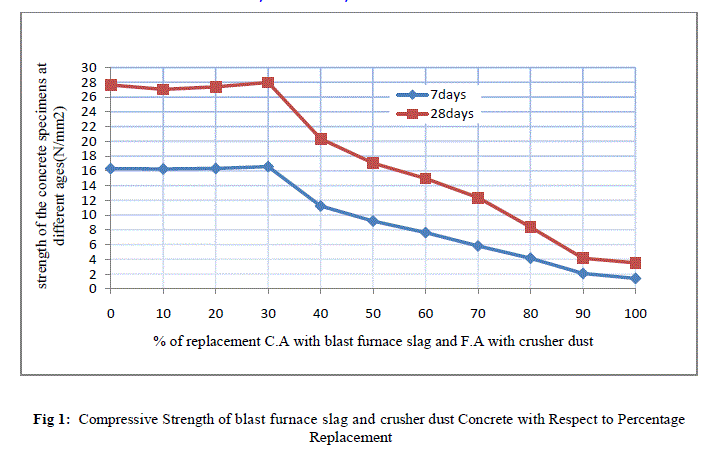 |
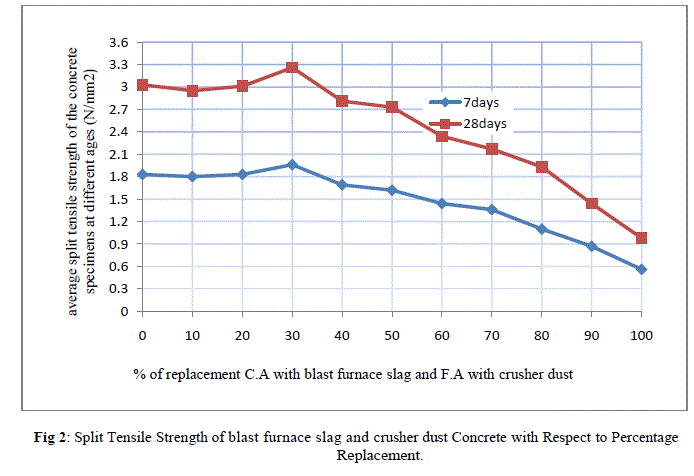 |
CONCLUSIONS |
| Based on the experiments performed in the laboratory, the following conclusions can be drawn with respect to M25 concrete mix |
| The physical properties of crusher dust and blast furnace slag are satisfying the requirements of fine aggregate and coarse aggregate. The cost of concrete made with blast furnace slag and crusher dust is less than conventional concrete because the crusher dust and blast furnace slag which were less cast. |
| At 30% replacement of coarse aggregate with blast furnace slag and fine aggregate with crusher dust there is no reduction in compressive strength with respect to controlled concrete. |
| At 30% replacement of coarse aggregate with blast furnace slag and fine aggregate with crusher dust that shown only marginal increase in split tensile strength and flexural strength was observed. |
| Based on this experimental investigation, it is found that crusher dust can be used as an alternative material to the natural river sand and blast furnace slag can be used as an alternative material to the coarse aggregate up to certain percentage. |
References |
|